
Newsletter of the Shell Club of Sydney
NSW Branch, The Malacological Society of Australasia Limited ACN 067 894 848

Gladstone Marina from 'The Australiana'
Members News, & Buy, Swap & Sell:
I have been a shell collector for over twenty five years and I collect all families, common to uncommon. I have a large trade surplus that I would like to exchange. I also buy and sell but prefer to exchange. If interested please send me a list of your available shells and I will forward to you a list of my available shells. If you prefer to sell shells please include prices with the list.
I also have common land snails mostly from the Philippines and a good supply of fossil marine shells.
Bob Emory
7937 Amandas Crossing
Jacksonville Fl. 32244 USA
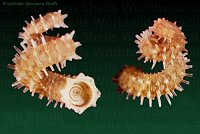
Swains 2000
By Steve Dean
I have finally cleaned and labelled all of my shells from the Swains trip (see last sheller for article). The Terebridae took the longest to clean.
I have prepared a list of the species I kept to give readers an idea of the varieties we encountered. As I kept specimens of most species, the list below probably includes 85% of all species collected during the expedition.
I have 8 species that I have not yet identified. The varieties collected that I did not get specimens of were mainly small Mitridae, Turridae and some Terebridae. I have only listed those I am certain of.
I noticed an interesting trend when searching the references for species names and details. Many of the specimens were their less common yellow or golden colour form. This was especially true for the bivalves. Bivalve species described as only yellow at the umbones or yellow internally were often bright yellow all over. Some of the sand shells of the outer Swains tend to be more yellow with brighter colours than is normal for their various species. (At least in the particular reefs we went to)
Bivalves:
Cardita incrassata
Glycymeris reevei
Arca ventricosa
Arca avellana
Barbatia foliata
Tucetona pectunculus
Lima lima vulgaris
Comptopallium radula
Mimachlamys lentiginosa
Chlamys squamosa
Lioconcha castrensis
Lioconcha annettae
Lioconcha ornata
Callista semisulcata
Pitar pellucidus
Pitar sp (515 Biv of Aust)
Fimbria fimbriata
Acrosterigma angulata
Acrosterigma elongata
Fragum fragum
Timoclea marica
Fulvia australe
Dosinia extranea
Dosinia histrio
Acrosterigma unicolor
Septifer excisus
Spondylus albibarbatus
Spondylus nicobaricus
Chama pacifica
Myochama anomoides
Tellina robusta
Tellina virgata
Tellina gargadia
Tellina minuta
Tellina exculta
Exotica clathrate
Tellina chloroleuaca
Tellina astrolabei
Exotica virgulata
Tellina servicostata
Tellina myaeformis
Macoma dispar
Tellina sp like tongana
Anodontia omissa
Barbatia amygdalumtostum
Gomphina undulosa
Atrina vexillum
Pinctada margaritifera
Gastopods & Others:
Oliva miniacea
Oliva guttata
Alocospira rosea
Nassa serta
Thais echinata
Thais armigeria
Drupa ricinus
Muricopsis fiscella
Cronia margariticola
Vasum ceramicum
Phos textum
Engina lineata
Engina alveolata
Peristernia fastigium
Nassarius glans
Nassarius coronatus
Nassarius splendidulus
Nassarius albescens
Nassarius concinnus
Nassarius sp.
Pyrene deshayesis
Mitra mitra
Vexillum granosum
Vexillum polygonum
Cancilla aegra
Vexillum exasperatum
Pterygia crenulata
Neocancilla clathrus
Lophiotoma acuta
Eucithara cylindrica
Eucithara sp
Pupa fumata
Pupa nitidula
Acteon virgatus
Diodora ticaonica
Diodora octogona
Patella flexuosa
Capulus danieli
Clanculus atropurpureus
Australium rhodostomum
Trochus maculatus
Trochus hanleyanus
Trochus histro
Monilea belcheri
Turbo perspciosus
Chrysostoma paradoxum
Ethalia guamensis
Pseudostomatella decolorata
Modus tectum
Malea pomum
Casmaria ponderosa
Semicassis angasi
Pyramidella acus
Pyramidella sulcata
Pyramidella terebellum
Otopleura sp
Terebra areolata
Terebra subulata
Terebra maculata
Terebra guttata
Terebra crenulata
Terebra cerithina
Terebra laevigata
Terebra punctatostriata
Terebra jenningsi
Terebra tricolor
Terebra affinis
Terebra dimidiata
Terebra cingulifera
Terebra chlorata
Conus textile
Conus mamoreus
Conus striatus
Conus imperialis
Conus miles
Conus ammiralis
Conus tessulatus
Conus spectrum
Conus miliaris miliaris
Conus litteratus
Conus pulicarius
Conus eburneus
Conus omaria
Conus litoglyphus
Conus generalis
Conus arenatus
Conus capitaneus
Conus ebraeus
Conus coronatus
Conus flavidus
Conus virgo
Conus suturatus
Conus frigidus
Conus ferrugineus
Atys cylindricus
Atys naucum
Bulla ampulla
Mitrella ligula
Dentalium longitrorsum
Psilaxis radiatus
Cerithium tenellum
Pseudovertagus aluco
Pseudovertagus phylarchus
Cerithium nodulosum
Rhinoclavis fasiata
Rhinoclavis aspera
Rhinoclavis traillii
Rhinoclavis vertagus
Maoricolpus roseus
Haliotis varia
Haliotis ovina
Strombus variabilis
Strombus gibberulus
Strombus dilatatus
Strombus lentiginosus
Strombus mutabilis
Strombus erythrinus
Terebellum terebellum
Natica gualtieriana
Natica vitellus
Natica pseustes
Natica onca
Polinices maurus
Polinices melastomus
Polinices aurantius
Polinices mammilla
Polinices peselephanti
Polinices powisiana
Melo amphora
Cymbiola pulchra f. peristicta
Amoria maculata
Amoria canaliculata
Lyria deliciosa
Trivia oryza
Cypraea lynx
Cypraea arabica
Cypraea eglantina
Cypraea errones
Cypraea caurica
Murex queenslandicus
Murex kerslake
Murex akritos
Tudivasum armigera
Additional Species kept, but not by me:
Haliotis asinina
Lambis lambis
Lambis truncata
Strombus labiatus
Vitularia crenifer
Vexillum costatum
Mitra fraga
Cancilla granatina
Codakia paytenorum
Hyotissa hyotis
Additional species observed that I think
no one kept:
Spondylus squamosus
Isognomon isognomon
Cypraea annulus

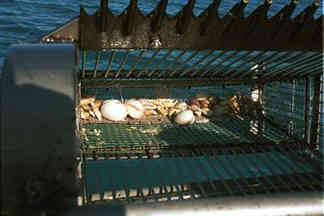
Fred with dredge
October Minutes 28/10/2000.
The meeting was opened by M. Anderson at 2:53pm following the annual shell show.
Maureen thanked A. Brown, S. Dean and R.Moylan for their efforts. Ron and our President P. Jansen were in New Zealand attending the Auckland Shell Show. Maureen welcomed new member Jackie Denistone (transferred from S.A.), plus Angas Hawkes and friend Shanti from the south coast.
Book Reviews Turned into a book auction this month. Angas Hawkes kindly donated "Shells of Queensland and the Great Barrier Reef", which was purchased by D. Woodhouse.
General Business
Note: The Christmas party / field trip to Callala Bay will be held on Sunday November 12th 2000, meeting time 12.00 noon for lunch at Callala Bay (not Callala Beach). Followed by a 3.32pm low tide for those interested in exploring the local habitat.
Treasurers Report
P. Pienaar reported that Ryde Eastwood was charging us for tea, coffee and biscuits and this would entail a $1.10 charge per person per meeting. It was agreed unanimously by the meeting to collect this fee via an honour system.
There was discussion about the shell show categories. It was decided that to allow for greater participation from the group, there should be some more general categories representing wider and more varied interests, for the next shell show. It was unanimously agreed that the categories be discussed at the AGM prior to the next annual shell show.
Meeting closed at 3:25pm.
C. & K. Barnes
Secretary
November Minutes 25/11/2000.
The meeting was opened by P. Jansen at 2:00pm.
Field Trip Report
Callala Bay NSW - Christmas Field trip. The trip to Callala Bay was attended by P. Pienaar and family, F. & K. McCamley, N. & M. Anderson, A. Miskelly, C. & K. Barnes. S. & K. Dean arrived later in the afternoon but as bad weather had set in everyone else had already departed.
Cypraea vitellus Linnaeus, 1758 were present, along with a few cones, one live
C. papilliferus Sowerby, 1834, lots of Eburnea Sp on the rocks,
Charonia lampas rubecunda (Perry, 1811) were quite large and common, a very dead
Mitra solida Reeve, 1844, but no Epitoniidae.
The day was drizzly, the rocks were muddy and slippery and the rock platform jutted out into the bay about 90 metres at low tide. Lots of marine life was present including, chitons, octopus, a dead volute
Cymbiola magnifica (Gebauer, 1802) a few Cabestana spengleri Perry, 1811 and lots of turbos in crevices close to the water some pectens and collumbellids. Maureen found a very mud encrusted $10 note. The bay appears to be the local nursery and breeding ground for sharks as egg cases and baby sharks abounded. Ashley also found a couple of small striped squid apparently named Sepioloidea lineolata
Quoy & Gaimard, 1832 at the edge of the rock platform among sand and sea grass.
New Zealand Shell Show, Auckland
Ron Moylan reported that the show was well attended. There was some material of exceptionally high quality and some exotic pieces, including a large display of endemic material. Ron made a video tape which he will present at the January meeting. Merv Cooper and Ron judged some of the categories. The weather was good and there were lots of shells on the beaches. Wellington will host the next show in three years time. The show was well organised and run. It wasn't quite as big as Melbourne or Sydney but was well attended by the general public.
General Business
According to the CSIRO, the New Zealand Mauri scalpas has invaded NSW, covering an area the size of Tasmania. We can only guess at the impact this must be having on the native scallops and screw shells. Ashley has collected them live at Bottle & Glass rocks in Sydney Harbour. Michael Keats reported that Ulrich Knodel has a new book out. The Protecting Wetlands Steering Committee of the Sydney Coastal Council wants volunteers. John Franklin has been nominated as a councillor for the MSA E-council where people from all over the world are connected by e-mail. The existing council of the MSA are not standing for re election. The Sydney members are pleading exhaustion. A new copy Waves was distributed. It was reported that Ron Evans, a cone collector from Nambour, has passed away.
Raffles
Maureen thanked R. Moylan, F & K. McCamley, M. Keats and P. Pienaar for donations of raffle prizes over the past year. However if we still want to have raffles we will need some prizes in the future.
Ron Moylan has had a cone shell named after him by a Belgian acquaintance in publishing. The Gloria Maris has named the
Conus moylani originally called Conus polygramus but believed to be a different species.
Chris Barnes reported finding a Cypraea chinensis Gmelin, 1791 at Little Bay, Sydney and finding a beached
Cypraea kieneri Hidalgo, 1906 at Malabar. These shells bring the number of species personally collected from the Sydney region to twenty nine.
Meeting closed at 3:12pm.
C. & K. Barnes, Secretary
Favourite spots around Sydney: Long Reef
Patty Jansen
Long Reef is one of my favourite spots around Sydney. Since it's a marine reserve and you are not allowed to collect, I take only a camera, but it is amazing what you might find on a day when the tide is out. After you have
walked across the beach, and, during weekdays, have shooed a few pelicans out of your way, you come to an area where a rocky reef runs almost at a 90 degree angle with the beach. About 50 metres behind this reef, in the middle of the platform that extends at low tide, is a shallow pool filled with lots of smallish loose rocks. This is really the most interesting part in all of the Long Reef area, so unless you are feeling energetic or the sea is particularly calm, there is no need to keep walking on, although the beach around the point is pretty, and there are lots of interesting seabirds at the point.
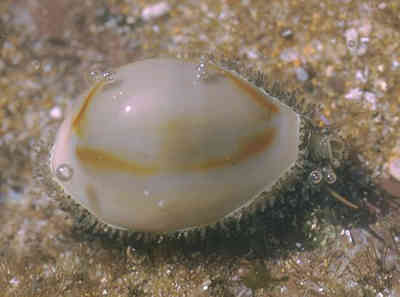
The rocks in the pool reveal a multitude of cowries, mostly. C. errones, erosa
or caputserpentis. They seem to live quite high in the intertidal, and a very low tide can almost be too low for them. In amongst these you will find quite a few
Mitra carbonaria, and thousands of small shells, such as Bittium granarium, Rissoina angasi
and various Columbellids, Trochids and Fissurellids. Conus papilliferus is also quite common there.
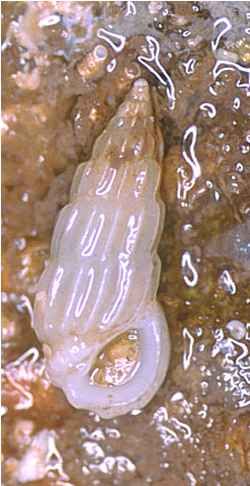
Rissoina crassi
Lower down you will find Scutus anatinus, Cabestana spengleri and Charonia rubecunda. Turbo imperialis has become very common in this area within the last few years. Whereas they were quite unusual then, now they are absolutely everywhere. Smooth shells, spined shells, and every variety in between. In this zone, sea urchins are very common, as well as all types of sea stars, worms, anemones. Blue-ringed octopus are very common at Long
Reef, so you have to mind your fingers when turning rocks.
Only at the very low tide mark you will find Haliotis coccoradiata and the occasional specimen of
H. rubra.
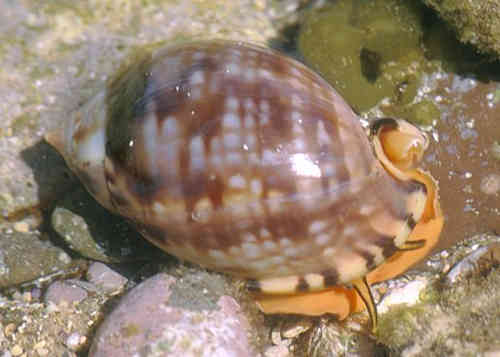
Sometimes when you're lucky you might find unusual things like Phalium labiatum.
As all intertidal areas, Long Reef is strangely temperamental. A few weeks back supposedly at the lowest tide of the year, Steve and I looked furiously but found little else but seastars and millions of chitons. At other times you will find a cowrie under every rock you turn. I prefer autumn and spring low tides to summer ones, because at these times it is not so busy and I feel the 'catch' is better at that time of the year. In winter, it is too windy, so water surfaces, through which you are trying to peer finding animals, are permanently rippled.
One thing you are sure to find at Long Reef when the tide is low: other shellers! On two seperate occasions I have met Steve Dean there completely by accident. On one of these days, after leaving Steve and Keith on the rock platform, we ran into Phil Coleman in the car park!
NEW SOUTH WALES
BRANCH
ANNUAL
SHELL SHOW
RESULTS
Saturday
28th October 2000
|
Categories
|
Position
|
Winner
|
|
Display of ‘White Coloured” Shells:
|
1st
|
Adrian
Browne
|
|
2nd
|
David
Woodhouse
|
|
3rd
|
Chris
& Karen Barnes
|
|
Display of Cones: size
above 60mm
|
1st
|
Adrian
Browne
|
|
2nd
|
Steve
Dean
|
|
Display of Cowries: size
above 60mm
|
1st
|
Chris
& Karen Barnes
|
|
2nd
|
Steve
Dean
|
|
Display of Cowries: size
30 to 50mm
|
1st
|
Chris
& Karen Barnes
|
|
2nd
|
Steve
Dean
|
|
Display of Cowries:
size under 28mm
|
1st
|
Chris
& Karen Barnes
|
|
2nd
|
Peter
Pienaar
|
|
3rd
|
Steve
Dean
|
|
Display of Harps:
|
1st
|
Peter
Pienaar
|
|
2nd
|
Adrian
Browne
|
|
Display of Endemic Volutes:
size above 60mm
|
1st
|
Peter
Pienaar
|
|
2nd
|
Adrian
Browne
|
|
Display of Mitres:
|
1st
|
Adrian
Browne
|
|
Display
of Marginella:
|
1st
|
Steve
Dean
|
Some
of the Judges comments:
White shells:
Lots of imagination – defining “white” is difficult. High standard
congratulations to all five entrants.
Cones: Both
excellent efforts!
Cowries 30mm – 50mm:
Both first rate!
Volutes endemic:
Both very fine.
Cowries under 28mm:
Quality of shells was very good. Labelling & Display were lacking in
some exhibits.
|







